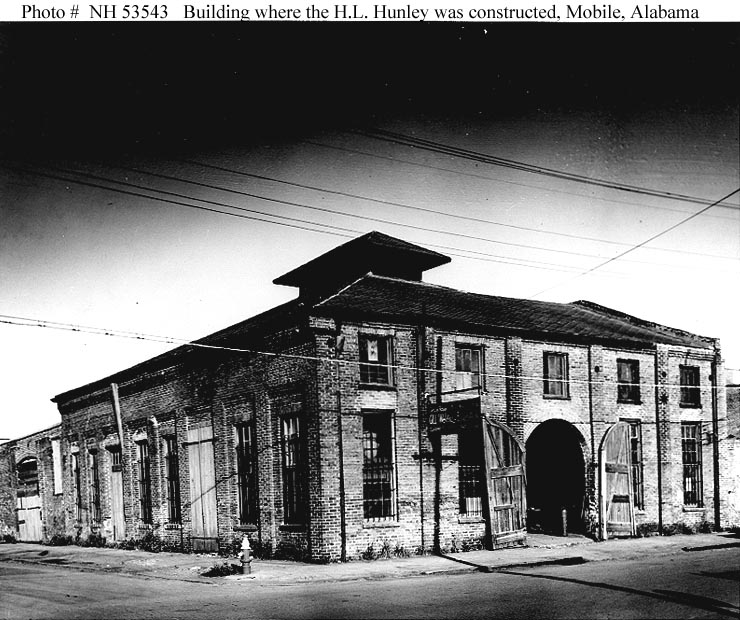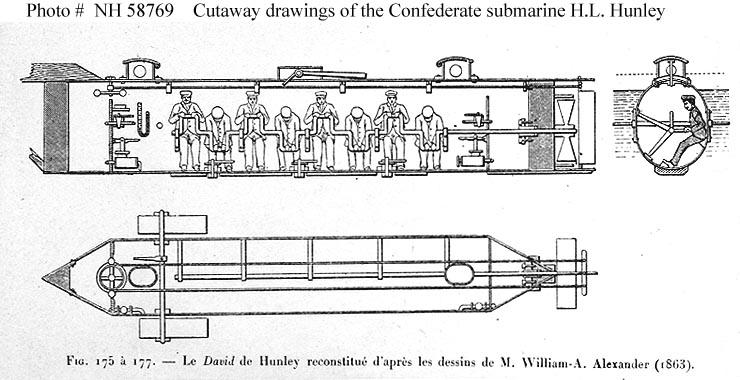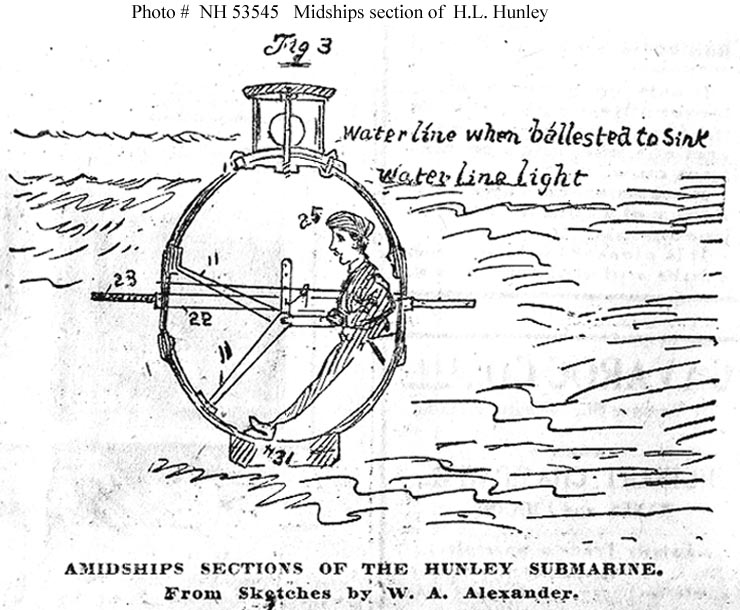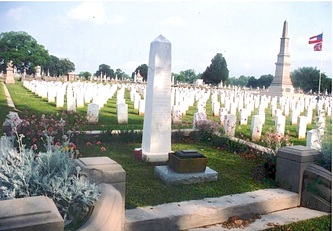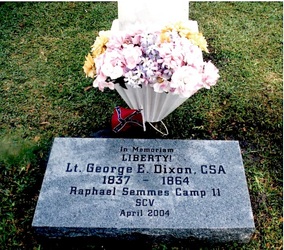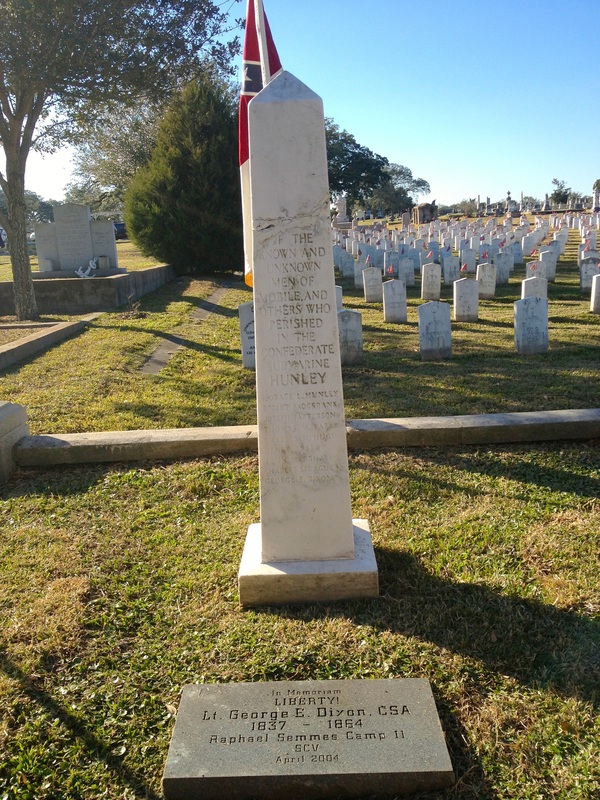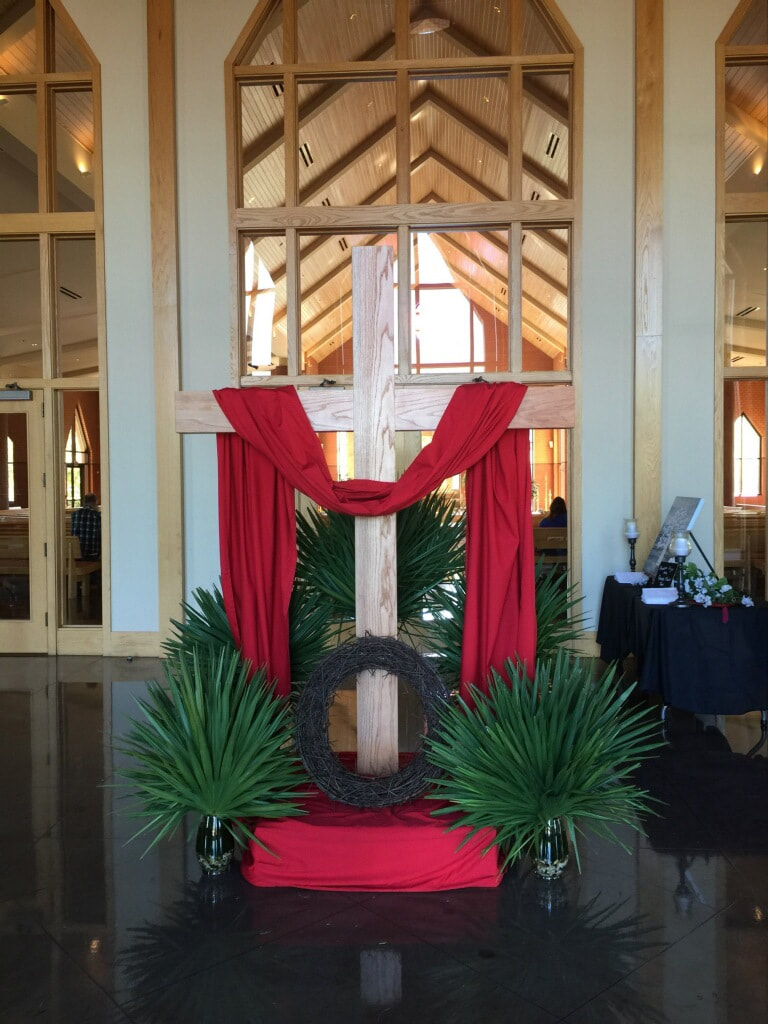ADMIRAL RAPHAEL SEMMES CAMP #11
SONS OF CONFEDERATE VETERANS
MOBILE, ALABAMA
The H.L. Hunley in Historical Context
The first effective submarine warfare was developed in the Confederacy. Note that the ship's name in not preceded by "CSS" because it was primarily privately funded with the hope of making a profit for its developers.
A treatise on the Hunley's development and its importance to the future of naval warfare may be found at here.
The first effective submarine warfare was developed in the Confederacy. Note that the ship's name in not preceded by "CSS" because it was primarily privately funded with the hope of making a profit for its developers.
A treatise on the Hunley's development and its importance to the future of naval warfare may be found at here.
The PDF below is the document produced by the National Park Service to seek funds from congress to raise the HL Hunley. It is an excellent source of information.
first views of the h l hunley february 12, 2012
"DEEp secrets"
from south carolina living
February 2013
By KEITH PHILLIPS
HANDS CLAD IN BLUE LATEX GLOVES, Paul Mardikian gently lifts the artifact that may unlock the 149-year-old mystery of the Civil War submarine H.L. Hunley.
“This is really interesting,” he says cradling the object in his palms the way a parent holds a newborn child. “It is changing the way we are looking at the attack on the Housatonic.”
Interesting? It’s a corroded piece of steel pipe, about the length of a man’s forearm, and so fragile that it could easily snap. The pipe is capped on one end by a jagged blossom of discolored copper sheathing that is held in place by a rusted iron bolt. To my untrained eye, it looks like a household plumbing project gone horribly wrong, but if this object is a vital link to the past, Mardikian would know. As the senior conservator at the Warren Lasch Conservation Center in North Charleston, he’s been working for the past 12 years as part of a multi-disciplinary team examining every square inch of the historic sub.
Under the direction of Senior Archaeologist Maria Jacobsen, scientists with the Clemson University Restoration Institute are using hightech tools and painstaking forensic techniques to restore and analyze artifacts recovered from the first submarine to sink a ship in combat. The team’s discoveries so far have made international headlines, been profiled in National Geographicdocumentaries and caused historians to rewrite much of the sub’s history, but the researchers are still working to answer the question: What sank theHunley?
The piece in Mardikian’s hands has the potential to unlock the answer, and Jacobsen calls the humble artifact “one of the most important finds to date.”
“This may be the closest thing that we in archaeology find in terms of the proverbial smoking gun,” she says.
Sailing into history
Ever since the night of Feb. 17, 1864, when the Hunley sank the Union warship USS Housatonic and failed to return to port, the fate of the submarine has been the source of endless speculation. The conventional narrative of the attack went something like this: Shortly after sundown, Lt. George Dixon and his crew squeezed into the cramped confines of their human-powered submarine. Affixed to a wooden spar atop the wedge-shaped bow was the submarine’s only weapon, a torpedo (today we’d call it a mine) filled with 60 to 70 pounds of black powder and fitted with a spiked barb.
Around 7 p.m., Dixon sealed the forward hatch and guided the Hunley away from its dock on the back side of Sullivan’s Island. The sub caught the outgoing tide flowing through Breach Inlet and turned toward the nearest Union blockade ship anchored offshore.
Hunley’s twin conning towers rode just above the water’s surface, allowing Dixon to peer through two round view ports as the sub neared the 205-foot hull of USS Housatonic. Union lookouts spotted the sub, sounded the alarm and began firing their rifles at the approaching object, but Dixon continued the charge, ramming the barb of the torpedo into the wooden hull near the stern on the starboard side. The barb held the torpedo in place as the sub backed away to a safe distance, spooling out a 100-foot lanyard that pulled tight and triggered the mine. The explosion effectively destroyed the stern of the Union ship, which sank within five minutes.
In the chaos that followed the blast, witnesses on shore and aboard the Housatonic claim to have seen a blue light thought to be Dixon’s signal to shore indicating a successful mission, but the sub and her crew were never seen again.
Trail of evidence
The fate of the sub is a tantalizing mystery made all the more so by the scarcity of reliable, first-hand information about the boat and her mission. Dixon and his crew had vanished, and few of the men who previously sailed the vessel survived the experience. On two separate training missions before the Housatonic attack, the submarine had flooded and plunged to the bottom of Charleston Harbor. The accidents killed 13 men, including Horace Lawson Hunley, a New Orleans attorney and would-be privateer who spearheaded the craft’s construction.
Confederates twice raised the sub and put it back into service, an indication of their desperate need to break the Union blockade; however, the “fish boat” was never an officially commissioned warship, and few records of her remain. Until recently, historians had to piece together highly speculative stories based on scattered—and often contradictory—sources, including an 1863 oil painting by Conrad Wise Chapman and accounts published in newspapers decades after the war.
That began to change in 1995 when a team of divers found the submarine intact and buried in the sand 300 yards seaward of the Housatonic wreck site. In August of 2000, recovery experts lifted the sub from the seafloor and placed it in the conservation center’s 90,000-gallon indoor tank, where scientists could control the process of corrosion that threatened to consume the iron hull. Like crime-scene detectives working a “cold case,” the researchers began gathering evidence to replace historical speculation with fact.
Historical revision
The first major revision to the Hunley narrative came from the unexpected discovery of the spar. Based on the Chapman painting, which shows a wooden pole protruding off the top peak of the Hunley’s bow, most people assumed that was how the sub carried its weapon. But as divers uncovered the intact vessel, they discovered the actual spar was a 16-foot-long steel pipe that was still attached to the bottom of the bow.
The spar was encased in a thick envelope of concretion—a rock-like combination of sand, shell and corrosion that forms around metal objects submerged in salt water—indicating an advanced state of decay. The tip of the spar actually broke off when divers tried to bring it to the surface, but both pieces were recovered and placed in a conservation tank before the team turned its attention to the complicated task of raising the hull.
Excavating the silt-packed interior of the submarine quickly took top priority, so the spar pieces were left to stabilize in a preservative sodium-hydroxide solution. For the past 10 years, they’ve been on public display during weekend tours of the lab.
Things change in a flash
The spar tip rose to the top of the conservation priority list late last summer. Using X-rays to guide him, Mardikian began chiseling away the concretion, bit by tiny bit, until he found the original surfaces of the artifact underneath. Conventional wisdom held that he would find the remains of a fitting that would have allowed the torpedo to slip off the spar, but the artifact emerging before him was something entirely different. At the end of the steel pipe sat a curious bloom of copper held in place by a bolt. Puzzled, he called Maria Jacobsen over to take a look.
Her immediate reaction: “Oh, my God.”
“I saw this flash of copper and frankly the hair stood up on my head,” Jacobsen recalls. “What you’re looking at here is not the end of the spar. You’re looking at the weapon system. We actually have part of the torpedo.”
The artifact matches a technical drawing in the archives depicting a Singer torpedo and bearing the notation, “Used for blowing up the Housatonic.” This Singer torpedo was a monster—packed with 135 pounds of black powder, nearly twice as much as the typical spar-mounted torpedoes used by Confederate boats—and it was designed to remain attached. Accordingly, many historians discounted it as the Hunley’s weapon of choice.
“For many years we thought that the torpedo had been released and left in the hull, and that they would have backed off and then detonated,” Mardikian says. “What this shows is that’s not what happened. They had that torpedo solidly attached to the spar when they attacked with no intention of leaving.”
The new evidence is clear: the Hunley was no more than 16 feet away when the torpedo went off, but Jacobsen and fellow archaeologist Michael Scafuri are quick to point out that there is no data to suggest that the blast itself sank the sub. The hull was found intact, and they’ve already proven that the three visible holes in the vessel’s iron shell formed after the Hunley sank, but the finding does help the team narrow the focus of the ongoing investigation.
“Any hypothesis that involves the submarine being more than 16 feet away from the Housatonic is probably now invalid,” Scafuri says. “It’s new information, but it doesn’t necessarily answer all of our questions.”
Next steps
Mardikian rotates the spar tip under an exam light to highlight the intricacies of the piece and the other reason the researchers are so excited by this latest find. In the moment of the blast, part of the torpedo’s copper sheath “peeled back like a banana,” and the entire sleeve was shoved several inches back against the retaining bolt, causing the pliable metal to crumple against one side of the nut like wadded paper. “You’ve got an ‘instant moment’ frozen in time right there,” he says.
Jacobsen explains that these details contain information that will help explosive experts recreate the blast. Using both physical models and computer simulations, they’ll be able to study the likely effects on the sub and the crew.
“With this one finding, not only can we reconstruct the attack strategy, we can reconstruct the charge, we can reconstruct the charge configuration and we know the distance of the Hunley from the weapon system and Housatonic,” she says. “Now we actually have data we can plug into an equation.”
The results of the simulation will coincide with the next phase of conservation—cleaning and stabilizing the hull. Sometime later this year, the fresh water in the conservation tank will be replaced with a diluted sodium-hydroxide solution capable of extracting the corrosion-forming salts that bonded with the iron during 136 years on the ocean floor. It will take years of treatment to fully stabilize the metal, but within just a few months, conservators can begin the mammoth task of chiseling the sub clean and examining their largest artifact.
What they will find is anyone’s guess, but each new secret extracted from the sub sheds more light on the true story of the Hunley.
“We’re about to enter a really intriguing phase,” Jacobsen says. “We can’t wait.”
“This is really interesting,” he says cradling the object in his palms the way a parent holds a newborn child. “It is changing the way we are looking at the attack on the Housatonic.”
Interesting? It’s a corroded piece of steel pipe, about the length of a man’s forearm, and so fragile that it could easily snap. The pipe is capped on one end by a jagged blossom of discolored copper sheathing that is held in place by a rusted iron bolt. To my untrained eye, it looks like a household plumbing project gone horribly wrong, but if this object is a vital link to the past, Mardikian would know. As the senior conservator at the Warren Lasch Conservation Center in North Charleston, he’s been working for the past 12 years as part of a multi-disciplinary team examining every square inch of the historic sub.
Under the direction of Senior Archaeologist Maria Jacobsen, scientists with the Clemson University Restoration Institute are using hightech tools and painstaking forensic techniques to restore and analyze artifacts recovered from the first submarine to sink a ship in combat. The team’s discoveries so far have made international headlines, been profiled in National Geographicdocumentaries and caused historians to rewrite much of the sub’s history, but the researchers are still working to answer the question: What sank theHunley?
The piece in Mardikian’s hands has the potential to unlock the answer, and Jacobsen calls the humble artifact “one of the most important finds to date.”
“This may be the closest thing that we in archaeology find in terms of the proverbial smoking gun,” she says.
Sailing into history
Ever since the night of Feb. 17, 1864, when the Hunley sank the Union warship USS Housatonic and failed to return to port, the fate of the submarine has been the source of endless speculation. The conventional narrative of the attack went something like this: Shortly after sundown, Lt. George Dixon and his crew squeezed into the cramped confines of their human-powered submarine. Affixed to a wooden spar atop the wedge-shaped bow was the submarine’s only weapon, a torpedo (today we’d call it a mine) filled with 60 to 70 pounds of black powder and fitted with a spiked barb.
Around 7 p.m., Dixon sealed the forward hatch and guided the Hunley away from its dock on the back side of Sullivan’s Island. The sub caught the outgoing tide flowing through Breach Inlet and turned toward the nearest Union blockade ship anchored offshore.
Hunley’s twin conning towers rode just above the water’s surface, allowing Dixon to peer through two round view ports as the sub neared the 205-foot hull of USS Housatonic. Union lookouts spotted the sub, sounded the alarm and began firing their rifles at the approaching object, but Dixon continued the charge, ramming the barb of the torpedo into the wooden hull near the stern on the starboard side. The barb held the torpedo in place as the sub backed away to a safe distance, spooling out a 100-foot lanyard that pulled tight and triggered the mine. The explosion effectively destroyed the stern of the Union ship, which sank within five minutes.
In the chaos that followed the blast, witnesses on shore and aboard the Housatonic claim to have seen a blue light thought to be Dixon’s signal to shore indicating a successful mission, but the sub and her crew were never seen again.
Trail of evidence
The fate of the sub is a tantalizing mystery made all the more so by the scarcity of reliable, first-hand information about the boat and her mission. Dixon and his crew had vanished, and few of the men who previously sailed the vessel survived the experience. On two separate training missions before the Housatonic attack, the submarine had flooded and plunged to the bottom of Charleston Harbor. The accidents killed 13 men, including Horace Lawson Hunley, a New Orleans attorney and would-be privateer who spearheaded the craft’s construction.
Confederates twice raised the sub and put it back into service, an indication of their desperate need to break the Union blockade; however, the “fish boat” was never an officially commissioned warship, and few records of her remain. Until recently, historians had to piece together highly speculative stories based on scattered—and often contradictory—sources, including an 1863 oil painting by Conrad Wise Chapman and accounts published in newspapers decades after the war.
That began to change in 1995 when a team of divers found the submarine intact and buried in the sand 300 yards seaward of the Housatonic wreck site. In August of 2000, recovery experts lifted the sub from the seafloor and placed it in the conservation center’s 90,000-gallon indoor tank, where scientists could control the process of corrosion that threatened to consume the iron hull. Like crime-scene detectives working a “cold case,” the researchers began gathering evidence to replace historical speculation with fact.
Historical revision
The first major revision to the Hunley narrative came from the unexpected discovery of the spar. Based on the Chapman painting, which shows a wooden pole protruding off the top peak of the Hunley’s bow, most people assumed that was how the sub carried its weapon. But as divers uncovered the intact vessel, they discovered the actual spar was a 16-foot-long steel pipe that was still attached to the bottom of the bow.
The spar was encased in a thick envelope of concretion—a rock-like combination of sand, shell and corrosion that forms around metal objects submerged in salt water—indicating an advanced state of decay. The tip of the spar actually broke off when divers tried to bring it to the surface, but both pieces were recovered and placed in a conservation tank before the team turned its attention to the complicated task of raising the hull.
Excavating the silt-packed interior of the submarine quickly took top priority, so the spar pieces were left to stabilize in a preservative sodium-hydroxide solution. For the past 10 years, they’ve been on public display during weekend tours of the lab.
Things change in a flash
The spar tip rose to the top of the conservation priority list late last summer. Using X-rays to guide him, Mardikian began chiseling away the concretion, bit by tiny bit, until he found the original surfaces of the artifact underneath. Conventional wisdom held that he would find the remains of a fitting that would have allowed the torpedo to slip off the spar, but the artifact emerging before him was something entirely different. At the end of the steel pipe sat a curious bloom of copper held in place by a bolt. Puzzled, he called Maria Jacobsen over to take a look.
Her immediate reaction: “Oh, my God.”
“I saw this flash of copper and frankly the hair stood up on my head,” Jacobsen recalls. “What you’re looking at here is not the end of the spar. You’re looking at the weapon system. We actually have part of the torpedo.”
The artifact matches a technical drawing in the archives depicting a Singer torpedo and bearing the notation, “Used for blowing up the Housatonic.” This Singer torpedo was a monster—packed with 135 pounds of black powder, nearly twice as much as the typical spar-mounted torpedoes used by Confederate boats—and it was designed to remain attached. Accordingly, many historians discounted it as the Hunley’s weapon of choice.
“For many years we thought that the torpedo had been released and left in the hull, and that they would have backed off and then detonated,” Mardikian says. “What this shows is that’s not what happened. They had that torpedo solidly attached to the spar when they attacked with no intention of leaving.”
The new evidence is clear: the Hunley was no more than 16 feet away when the torpedo went off, but Jacobsen and fellow archaeologist Michael Scafuri are quick to point out that there is no data to suggest that the blast itself sank the sub. The hull was found intact, and they’ve already proven that the three visible holes in the vessel’s iron shell formed after the Hunley sank, but the finding does help the team narrow the focus of the ongoing investigation.
“Any hypothesis that involves the submarine being more than 16 feet away from the Housatonic is probably now invalid,” Scafuri says. “It’s new information, but it doesn’t necessarily answer all of our questions.”
Next steps
Mardikian rotates the spar tip under an exam light to highlight the intricacies of the piece and the other reason the researchers are so excited by this latest find. In the moment of the blast, part of the torpedo’s copper sheath “peeled back like a banana,” and the entire sleeve was shoved several inches back against the retaining bolt, causing the pliable metal to crumple against one side of the nut like wadded paper. “You’ve got an ‘instant moment’ frozen in time right there,” he says.
Jacobsen explains that these details contain information that will help explosive experts recreate the blast. Using both physical models and computer simulations, they’ll be able to study the likely effects on the sub and the crew.
“With this one finding, not only can we reconstruct the attack strategy, we can reconstruct the charge, we can reconstruct the charge configuration and we know the distance of the Hunley from the weapon system and Housatonic,” she says. “Now we actually have data we can plug into an equation.”
The results of the simulation will coincide with the next phase of conservation—cleaning and stabilizing the hull. Sometime later this year, the fresh water in the conservation tank will be replaced with a diluted sodium-hydroxide solution capable of extracting the corrosion-forming salts that bonded with the iron during 136 years on the ocean floor. It will take years of treatment to fully stabilize the metal, but within just a few months, conservators can begin the mammoth task of chiseling the sub clean and examining their largest artifact.
What they will find is anyone’s guess, but each new secret extracted from the sub sheds more light on the true story of the Hunley.
“We’re about to enter a really intriguing phase,” Jacobsen says. “We can’t wait.”
HUNLEY'S SENIOR CONSERVATOR SHOWS THE SUB'S SPAR TIP WHICH REVEALS THAT THE TORPEDO WAS STILL ATTACHED TO THE SPAR WHEN IT WENT OFF.
Commemoration of the h l hunley at Mobile
In 2004, Camp #11 interred a portion of the sediment from the Hunley. It remains a feature of the monument to the crew who lost their lives in the vessel.
2019 memorial held in Mobile
PDF files require Adobe Acrobat Reader. Download the latest version here.

